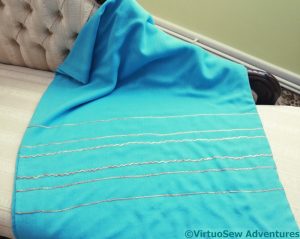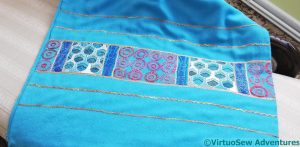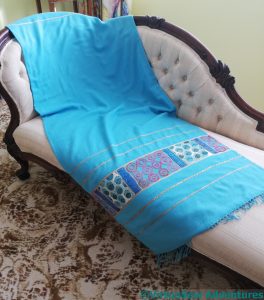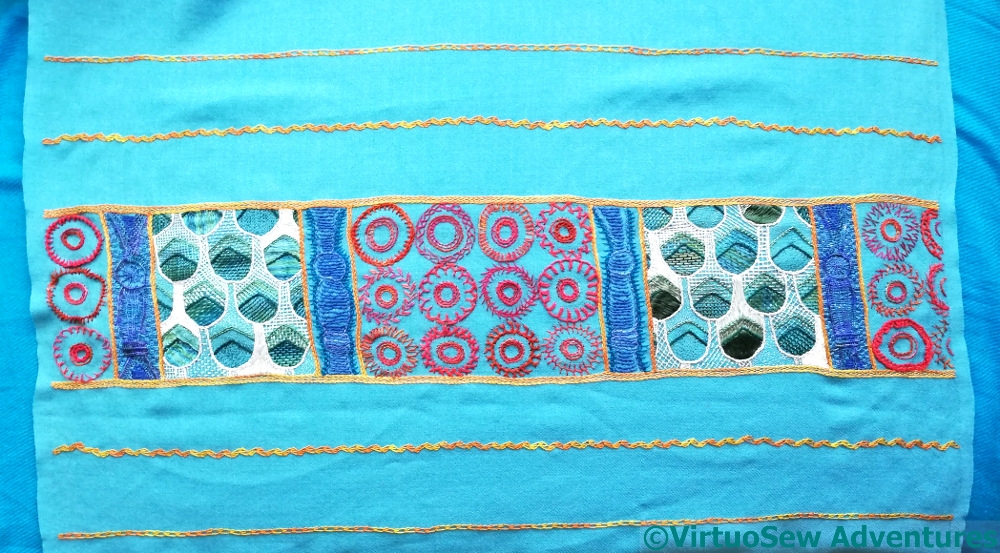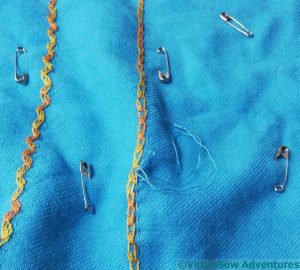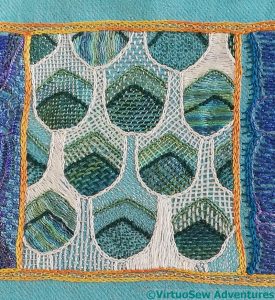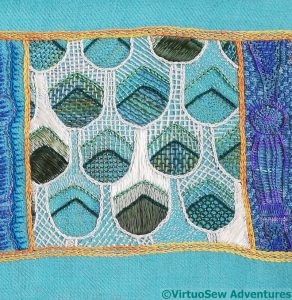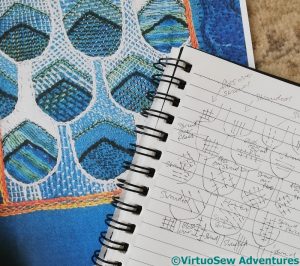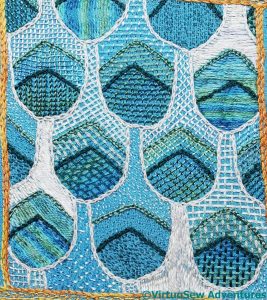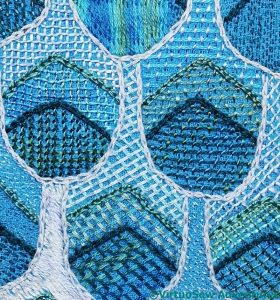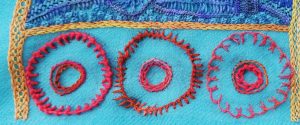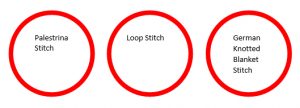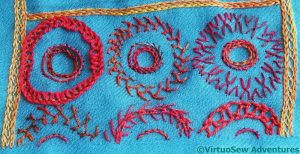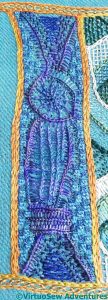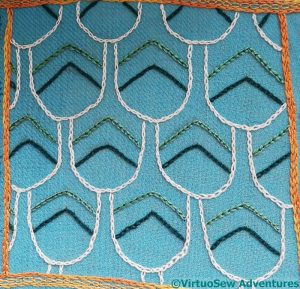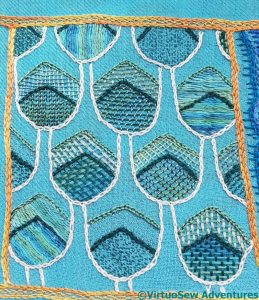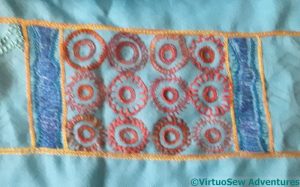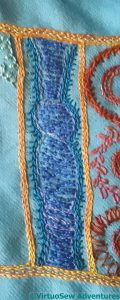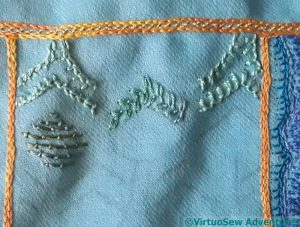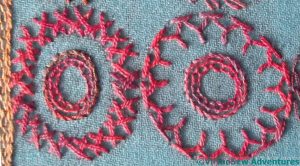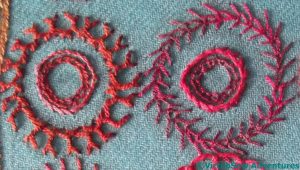Tag: Nefertiti Shawl
Finally, completely finished!
More progress on SlowTVStitchery – Episode Eight is now up. It contains intimations of dilemmas to come… Enjoy!
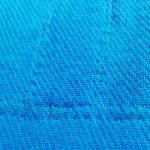
After washing the pashmina for the lining several times (it dyed the water bright turquoise the first three times at least, with no discernible fading in the fabric), ironing both of them, and pinning them together with safety pins, I settled down with my turquoise silk thread and ran simple running stitch quilting along all the gold lines of the design. This was easiest to do, I found, by cutting the thread to a little over the width of the pashmina and starting in the middle of both the thread and the shawl. Once the main lines were in place, I went back to the polychrome band and added the extra lines of stitching to delineate the frame.
It’s not easy to see, although I’ve done my best with this photo, but I’ve worked several rows of variegated golden lines across the pashmina on the otherwise undecorated end. I felt, when I finished the polychrome band that the whole thing looked a little unbalanced, and needed something to prevent the impression of something just fading out. I used Wavy Chain, Shell Chain, and Cable Chain, which are used on the other end, too.
And here is the polychrome band. You can see that the proportions aren’t quite perfect, but it is very much in the spirit of the StitchOff that the pashmina was originally bought for, in that it is intended to be worn and enjoyed, not stuck up on a wall. It wasn’t quick to do, but that is the fault of my own talent for over complication!
At long last, the Nefertiti Shawl is finished and lined, the lining has been controlled with lines of stitching, and the whole thing has been pressed. It should be seriously cosy – the lining is another cashmere pashmina, and it clings slightly as I wrap it around myself. It’s not an easy piece to photograph, hence the languorous drape over the sofa!
Last details on the Nefertiti Shawl
Well, at last!
As you can see, I didn’t perfectly centre my sketch of the design when I put it on the pashmina, but once it’s swept around my shoulders, I doubt very much whether anyone will notice!
I’ve also put a narrower set of gold lines on the other end. I didn’t want to work the whole thing again, but I felt that a little extra colour would nevertheless help to make the whole this look a bit more thought-out. Or at least, more completely evolved!
However, I did decide that in the interests of not spending all my time on maintenance, I was going to line it, and I found another turquoise blue pashmina with which to do so. It is slightly narrower (so I turned in the selvedges of the embroidered one to meet it), slightly longer, and doesn’t have a fringe. So I could line just the fabric length, and cut off the excess.
How to control the fabrics while I was doing so gave me a little trouble, until I remembered seeing quilters use safety pins to “tack” fabrics together. That worked beautifully!
I spent a couple of evenings working running lines beside each of the gold lines. Just straight running stitch – in the case of Wavy Chain, I simply offset the line a little, rather than trying to follow the zigzags.
SlowTV Stitchery continues – Episode Four and Episode Five are both now up to view. Enjoy!
Nefertiti Shawl – Green Panels finished
So here is the first of the green panels.
I’ve used stranded and floss silks, in variegated and plain colours.
The stitches are Woven Stitch, Bokhara Couching, Trellis Couching, Burden Stitch, and Darning Stitch, and wherever it’s possible to use two different threads in a stitch, I have done so, usually contrasting a plain with a variegated colour, or (sometimes and) a stranded with a floss silk.
Oh, I forgot – there was stitch orientation, too – vertical, horizontal, right-facing diagonal, left-facing diagonal!
Okaaaay. That made the “duality” idea a tad daunting, but not half so confusing as starting without any plan at all!
Anyway, the result is that the areas of high stitch density and high reflectance have been moved around a bit, and the details of the patterning have changed a bit, too.
I’m going to drape the panel somewhere I can see it for a couple of weeks, to be sure I’m happy with how it’s turned out, and then I’m going to line it with another pashmina. I’m planning to stitch in self-colour along all the gold lines, which will provide a slightly quilted look, and control the fabric a bit better, too.
Not to mention, making for a seriously cosy shawl!
Nefertiti Shawl – an excursion into duality
Having completed one green panel, I decided that I wanted the other green panel to be not quite the same, and I couldn’t work out how to approach keeping the family resemblance and maintaining some sense of balance.
So I asked The Australian, who you may remember is also a mathematician. He looked at me in some perplexity for a while. In fact, as I explained the layers of patterns I’d created, he eyed me more than a little askance, and then went very quiet for a while (you’d think he’d be used to it by now…).
Finally, he suggested I think about duality. Now, this isn’t a philosphical thing – it’s quite tightly defined, in the geometrical sense, at least – see this Wikipedia page – so after some discussion over lunch, we decided that if I were to regard the elements of the two green panels as duals of one another, it would give me a systematic way to approach the second one, rather than flailing around randomly.
Now I had to decide what was what’s dual….
For example, in the first panel, I chose between floss silk or stranded silk, and in the case of stranded, between solid colour and variegated; then in terms of stitch orientation (going clockwise), between vertical, diagonal, horizontal and the other diagonal. In this context, I’m not sticking to the idea of a binary choice, so for example with stitch orientation I will go to the next 45degree angle around the clock face, while with the thread, I’m going to pick some ordering of variegated stranded, plain stranded and variegated floss and then move along to the next in that sequence.
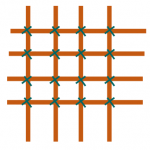
In terms of the stitch choice, essentially there are four: Jacobean trellis, darning stitch (rows of irregular running stitch, in effect), Bokhara couching, and Woven Stitch.
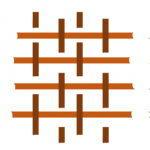
I can choose to make Bokhara Couching and darning stitch each other’s duals – that will move the heaviest stitching to different places in the panel.
The other two will be each other’s duals, with the added complication that they have each involved two different threads.
Have I simplified my life or complicated it?
Green panels, Nefertiti Shawl
There are two green panels in the design of the Shawl, which is based on the polychrome panel around Nefertiti’s famous (and unique-to-her) headdress, and they’ve been giving me no end of trouble.
If I’m completely honest, in fact, this whole piece has been giving me no end of trouble. The fabric is particularly mobile (although not quite as bad as that other pashmina I did!), and it’s been hard to find stitches that work comfortably. Originally I was working it in the hand, and that made it even harder.
In the end I outlined the design sections with chain stitch, and then picked a few stitches and threads. I tried to get some sense of variation in stitch density as well as colour. So there are complete coverage sections (using Bokhara Couching) and almost-no-coverage sections (using darning stitches) and almost everything in between (everything else)!
I’ve also changed and counterchanged between variegated and solid colours, and between floss silk and stranded silk. This is one of the reasons I ended up needing The Australian’s mathematical eye to help me keep track of the pattern I was building up in my haphazard way!
Nefertiti Shawl – partial panels
There are partial red panels at the edges of the Shawl, and as I want the colours to run the whole way across, clearly I have to stitch them. While I was mulling over the blue panels and the green ones, I carried on with those partial panels.
The central circles in all cases are in chain stitch and stem stitch, but I wanted a variety of effects in the main circles. That wasn’t as easy to achieve as you might think, for all my extensive repertoire of stitches! I found “German Knotted Blanket Stitch” in Barbara Snook’s “Embroidery Stitches”, and Palestrina and Loop Stitch are old friends, but by this point I’d managed to rack my brain into remembering most of those..
I was beginning to be at my wits end for stitches, and spent some time rummaging in Edith John’s “Creative Stitches” and “New Stitches for Embroidery”. Many of them would be easier in a slightly stiffer thread at a slightly larger scale, so I find myself wondering what Miss John devised her stitches for.
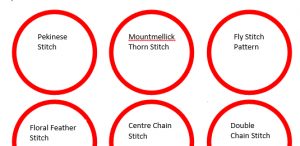
The full circles here are in stitches which are old friends, but the partial circles are some of hers. Floral Feather is a feather stitch with an upside down blanket stitch beside it, and I quite fell in love with it. I’ll be looking for another opportunity to use that one!.
Centre Chain stitch alternates single chain with fly stitch, starting each chain stitch within the previous one. That might be a way to vary textures with Wheatear Stitch, while still keeping the overall pattern. And Double Chain Stitch places a chain stitch and an open chain stitch side by side, alternating the ordering to create a checked effect.
Nefertiti Shawl – the second pair of blue panels
You may recall that I wasn’t entirely happy with the the first two blue panels. I’m still not entirely sure why, but I decided that I would work the second pair rather differently.
The outline of the pillar like shape, this time, was in Vandyke stitch using a Stef Francis variegated silk. Tricky, on such a mobile fabric, but I liked it enough to keep going, and moved on to a background using Sorbello Stitch. I rather like Sorbello Stitch – I used it for the villages on the Map of Amarna – and because I was working it at a tiny scale, the mobility of the fabric wasn’t a huge problem.
On to the internals of the pillar like shape, and I started with a Ceylon stitch wheel. This is a needlelace stitch, and even with the fabric in a hoop, tension was an interesting challenge…
I’ve also made the background a chequerboard of Sorbello Stitches in two shades of blue. I must have really enjoyed myself!
Finally, I filled the rest of the body of the pillar with Ceylon Stitch. Tension was even more of a problem here, and I may have to come back to this and tweak it, restitch it, or even change my mind again. We’ll see!
In the meantime, however, I have to do another one on the other side of the panel.
Finally, a way forward
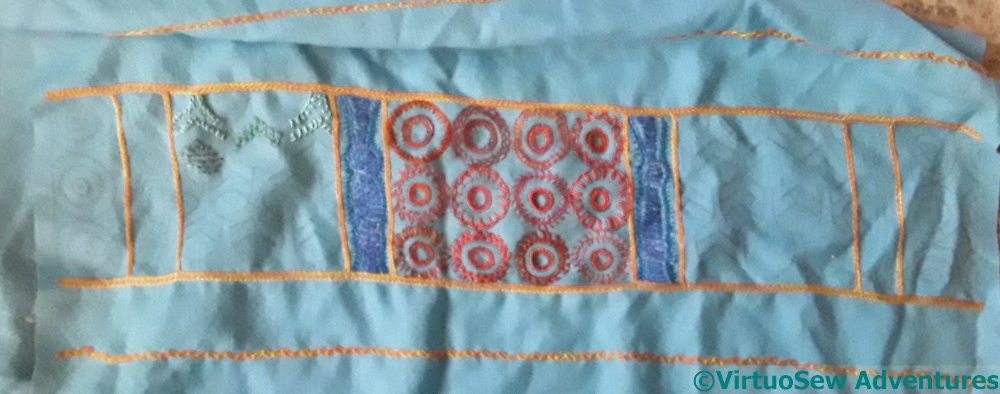
The Nefertiti Shawl started with great enthusiasm, but I ran into a few hitches. I’m not at all confident of the blue panels, and my first couple of efforts on the green ones took me nowhere at all.
Finally, I came up with a possible way forward. The scale pattern is taken from one of the Tutankhamen coffin panels, among other places, and each scale is outlined in gold, but the coloured fill is in progressively darker colours, not edged.
I’ve edged the scales with a very pale shade, and outlined the colour progressions in darker shades. The fabric is very mobile, so a little more definition may help..
I’ve picked several filling stitches, and I’m working them in various orientations, and several different combinations of solid and overdyed colours in stranded silk and silk floss.
That paragraph glosses over some considerable confusion and head scratching. Being so closely involved, I lost track of the sequence of patterns, and had to call for the assistance of The Australian’s mathematical and analytical eye!
Lost Momentum…
I’ve run into a bit of a problem here. I still love the idea, and I still want to finish the Nefertiti Shawl, but I’ve lost all momentum, and all sense of structure.
I’m happy with all the red circles. I like the colour variation and the unevenness – in real life, in a half-decent light, which winter in Britain rarely provides, there’s a vibrant, lively feel, and the use of the line stitches reflects the original pattern I used for the filling. Good.
The blue section is where the trouble started. I’ve done two of them already in spite of my doubts because I’ve come across all too many instances where a piece only worked when I’d kept on through the doubts.
I’m not sure whether it is the yarns, the colours, or the stitches that are the problem, or even whether there is a problem at all.
The pashmina is in a lovely twill weave which flows beautifully, but it’s quite fine, and a lot of the threads are thicker.
But the problems of the blue section fade into nothing when I get to the green. I love the overlapping scale pattern, and I was really looking forward to stitching it. But I can’t find a pattern of stitching that works, and again, I’m not sure whether this is the colour, the thread, or the stitch.
I have no idea how to sort this one out. Unless inspiration strikes, it will be some time before you see it again.
The Red Panel on the Nefertiti Shawl – Part Three
Third installment..
Remember, the two inner circles are always in the same stitches – Open Chain Stitch, and Stem Stitch.
The two outer circles in this case are in Herringbone Stitch, and Half-Chevron Stitch. I’m a little disappointed that neither the counterchanges of colour nor the counterchanges of thread seem to show in this photo. I assure you, they were there when I worked it!
The first of these is Breton Stitch, which is a little like Herringbone stitch with added twist. I’m sure I could have done it with the twist towards the outside, but I think like this, it will balance some of the other circles which have a strong edge.
The second is Wheatear Stitch, which I have found myself turning to every now and again, although maybe not often enough. It produces a spiky but continuous line, so while it has definite uses, it is also one which doesn’t work in all contexts. That said, I enjoyed working it, so maybe I will be able to tweak either the context or the stitch, so as to use it more…!
This pashmina is going to be quite the stitch sampler, isn’t it!

